
Lolium persicum is a species of flowering plant in the family Poaceae. It is referred to by the common names Persian darnel or Persian ryegrass, and is an annual grass. It has an upright stem, branching from a reddish base, up to 45 cm tall. Its leaves are lower surface glossy, dark green, 6 mm wide.

Agrostis nebulosa is a species of flowering plant in the family Poaceae. It is referred to by the common name cloud grass, and is an ornamental plant native to Morocco, Portugal and Spain. This plant is often cultivated for its light delicate heads that are used dried in floristry.

Helleborus cyclophyllus is a flowering perennial plant in the family Ranunculaceae. It is native to Albania, Bulgaria, Greece, and Yugoslavia. It is similar in appearance to other hellebores found in the Balkan region. It is acaulescent, meaning it lacks a stem with leaves, instead sending up a leafless flower stalk. The green leaves are palmate and basal, spreading at the ground. The flowers are green to yellow-green and 2 to 3 inches in diameter.
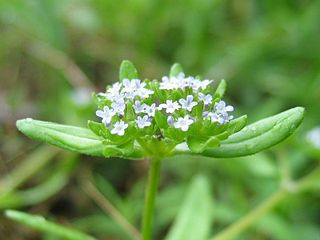
Valerianella is a genus of plant in family Caprifoliaceae. Many plants of this genus are known by the common name corn salad or cornsalad, although that name most often refers to Valerianella locusta.
Umbilicus chloranthus is a species of flowering plant in the Crassulaceae family. It is referred to by the common names green Venus' navel and ombelico di Venere verdastro. It is native to Albania, the East Aegean Islands, Greece, Turkey, and Yugoslavia.
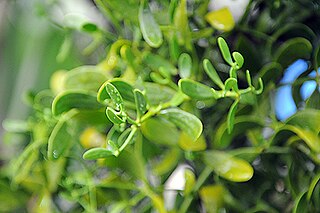
Viscum cruciatum, commonly called the red-berry mistletoe, is a species of mistletoe in the family Santalaceae. It is native to Lebanon, Morocco, Palestine, Portugal, Spain, and Syria.
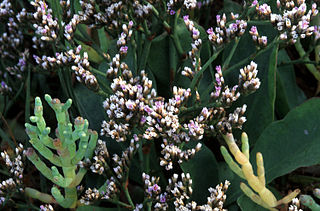
Limonium californicum is a species of sea lavender in the family Plumbaginaceae. It is known by the common names western marsh rosemary and California sea lavender.
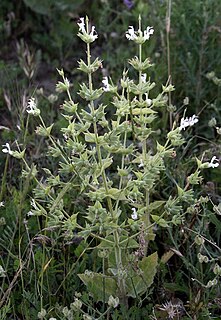
Salvia macrosiphon is a species of flowering plant in the mint family, Lamiaceae. It is native to Iraq, Iran, Pakistan, Afghanistan, Transcaucasia, and Turkey, where it grows at the edges of fields. It is a perennial herb with a white corolla and ovate nutlets. It flowers in May and fruits from June onwards. Although the plant is similar to S. spinosa, it differs in that it has narrower leaves and calyces, is less indurate and has less spiny fruiting calyces, and possesses a longer corolla tube.

Salvia judaica is a species of flowering plant in the Lamiaceae family. It is a perennial commonly called Judean sage that is native to Mediterranean woodlands and shrublands, with violet flowers blooming from April–June.
Clypeola elegans is a species of flowering plant in the family Brassicaceae. It is native to Iran, Transcaucasia and Turkey.
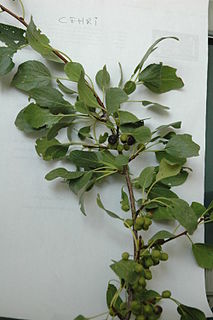
Rhamnus petiolaris is a species of flowering plant in the family Rhamnaceae. It is native to Iraq, Lebanon, Syria, and Turkey.
Salvia microstegia is a herbaceous perennial plant in the family Lamiaceae. It is native to Israel, growing on Mount Hermon. The plant has white or pale violet flowers, blooming from June to September.
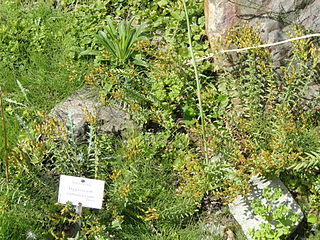
Hypericum rumeliacum is a species of flowering plant in the family Hypericaceae, native to southeastern Europe.
Cotoneaster granatensis is a species of flowering plant in the family Rosaceae that can be found in Algeria, Morocco, Spain and Tunisia. It was described in 1836.
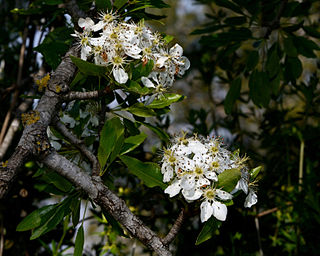
Pyrus syriaca is a deciduous tree in the Rosaceae family. It is referred to by the common name Syrian pear. It is the only pear species which grows in the wild in Lebanon, Turkey, Syria and Israel.

Papaver rupifragum is a species of flowering plant in the poppy family, Papaveraceae. It is native to Morocco and Spain.

Teucrium aroanium is a species of flowering plant in the family Lamiaceae. It is endemic to Greece.
Hypericum pubescens is a perennial herb in the Hypericaceae family. It is in the section Adenosepalum.
Asperula breviflora is a species of flowering plant in the family Rubiaceae. It was described in 1849 and is endemic to Syria.

Goniolimon tataricum is a species of flowering plant in the genus Goniolimon, family Plumbaginaceae. It is called German statice, Tatarian sea-lavender, Tartarian statice or just statice. It is native to Albania, Algeria, Bulgaria, Greece, Kazakhstan, the North Caucasus, Romania, Southern Russia, Tunisia, Ukraine and the former Yugoslavia. It is planted in gardens as a border and ground cover, and also used in the cut flower industry.














